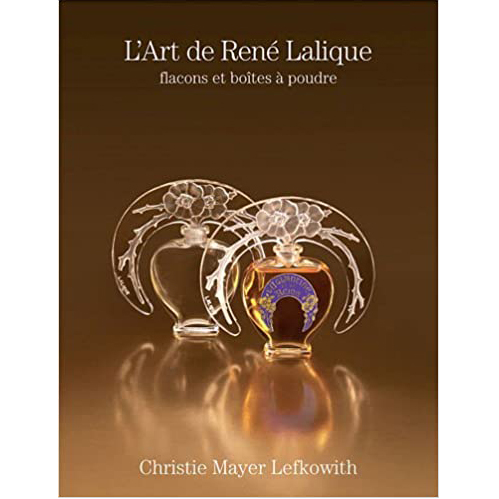The book combines years of work of eminent expert on perfume presentation art: Christie Mayer Lefkowith, with the treasure-trove of the most purposeful Lalique perfume collector: Silvio Denz. To that mix, give the author a free hand and total access to the archived material, i.e., drawings, orders, letters, and financial records of Lalique et Cie. Add every available Lalique perfume related item, many in full page fabulous detail and in multiple relevant views. Then package it with the sophistication of the finest perfume presentation. Beauty joined to energy; this is a very big book.
What you will not find: A table of contents; Numbered chapters; A precise chronology.
What you will find: A larger-than-life tribute to an artist who was larger-than-life. Commissioned by Silvio Denz, President and CEO of Lalique S. A., to commemorate the 150th anniversary of Rene Lalique’s birth (1860), this book was also intended to dedicate and inspire the work and operations of his newly acquired company.
Prologue: An overview of Rene Lalique’s early life – events and training as he emerged – not only as an artist, but also as a man of business. Early works are shown that preview creativity to come.
Creations of Rene Lalique flacons and powder boxes: Having established his reputation in design, over time, Lalique provided flacons and packaging for the greatest and most prestigious perfumers and couturiers and to many who wanted to be. Presented by theme or common elements of design, items are paraded by the reader. A delightful bonus is the historical background of each company. The total picture is done with infinite patience and thoroughness. Anecdotes of the events, literature, and personalities of the time give a more complete picture of the world of Lalique and his contemporaries.
Given structure by the commissions and creations for individual companies, the organization follows Lalique’s discoveries of glass as a medium and expression in every possible aspect – short, tall, round, lens-shaped, concave sides, convex portions, glass defined by the liquid inside and liquid defined by glass. We move through classical, the grotesque, the free, the tortured, women; draped and un, classical, mythical, androgynous, feminine, confined and liberated. We see bugs, lizards and snakes along with every type of flower and brier. We visit more options for design placement and detail than there are logical possibilities. And it is all beautifully done. Lalique’s sketches are all pictured with an orange background – clearly differentiating them from photos of models or realized pieces. The background for these, in every case, a neutral light gray, gives zero distraction while providing a sophisticated visual unity to the book itself. Each photo caption is wonderfully simple, including the name of the company, the fragrance or product name, a focus word or two, the dimensions if appropriate, and the year. It should also be noted that the photos and the text are seamless – one never overrunning the other. The author’s descriptions, in close proximity to the visuals are amazingly precise and accurate – the illustration a mere confirmation. While the inevitable mysteries evoke some whimsy and speculation on the author’s part, expect no gossip. Through the text, one develops a sense of how events like the war, victory, the Olympics, the stock market crash influence not only the style or design of the flacon, they sometimes shaped the entire industry.
Epilogue:Here is the summary of Lalique’s innovations of design reminding us that each design has a story of its own. We revisit the versatility- each portion of the bottle, each method for working or finishing glass provided a many-faceted creative opportunity. Who knew there were so many possibilities or that they could evolve so spectacularly? We are reminded that the total package was made up of many components. We see Lalique as a practical and successful businessman who was able to assess and modify – defying the oxymoron of mass-produced luxury.
Notes: Here find the documentation and additional details and even some more stories.
Acknowledgments and Bibliography: The usual – good food for further study.
Reviewed by Verna Kocken
